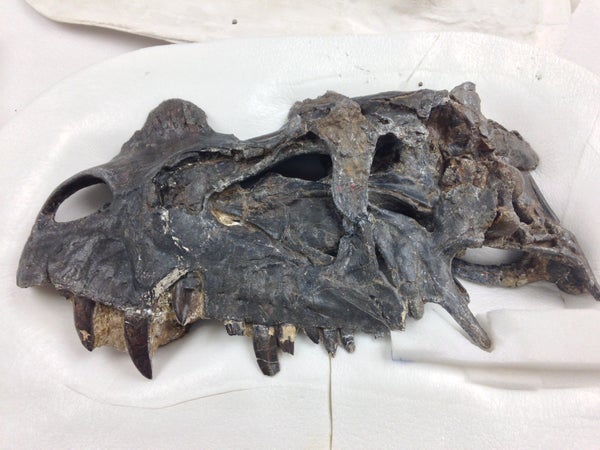This article was published in Scientific American’s former blog network and reflects the views of the author, not necessarily those of Scientific American
If I had a time machine, but only one ride on it, I know where and when I’d visit. I’d want to go back to the location of the modern Utah-Colorado border around 150 million years ago. So long as the coordinates didn’t plonk me into the middle of a lake or some other tricky spot, I expect I’d look out the glass pane to see a Jurassic Serengeti - herds of sauropods eating their fill among stands of conifers, a Stegosaurus grumpily shambling by as an Allosaurus darts through the shadows on the edge of a fern-covered floodplain bordered by thick forests. Closer up, small crocodiles, mammals, lizards, and more would fill out the cast, with pterosaurs flapping overhead. As far as Mesozoic diversity goes, it’d be harder to get more bang for your buck.
But our views of Morrison Formation life may be a little… rich. It’s easy to print out a list of all the Morrison Formation species and be instantly awed by the dozens of dinosaur species and other forms of life. But the Morrison Formation covers an immense amount of land - about 1.5 million square miles from Montana to Arizona, from Oklahoma to Utah, spanning eight million years in all. Even considering the Jurassic celebrities, some dinosaurs - like Allosaurus - are ubiquitous while Brachiosaurus and the armored Mymoorapelta are rare. The Morrison Formation doesn’t present us with a monolithic and stable assemblage, in other words, but ten million years of similar, but shifting, ecologies. To that end, John Whitlock, Kelli Trujillo, and Gina Hanik have assembled a pterosaur’s-eye view of what the Jurassic west was really like.
The researchers mapped out 291 fossil localities across the Morrison Formation’s range, organizing them into four smaller subsets - Montana, South Dakota, and northern Wyoming to the north; Utah and western Colorado to the west; eastern Colorado and southern Wyoming to the east; and Arizona, New Mexico, and Oklahoma to the south, all compared with a mind to how the localities are situated in time. What the paleontologists were looking for were species patterns across space and time, trying to come up with an image of how Morrison Formation communities differed.
On supporting science journalism
If you're enjoying this article, consider supporting our award-winning journalism by subscribing. By purchasing a subscription you are helping to ensure the future of impactful stories about the discoveries and ideas shaping our world today.
If you wanted to see the most dinosaur species, then, Whitlock, Trujillo, and Hanik would probably tell you to stick to the north, west, and east. These regions boasted 21 to 22 different genera of dinosaurs, while the southern region only had about 10. Sauropod dinosaurs make up most of this disparity. For reasons as yet unknown, there appear to have been fewer of them in the southern part of the ecosystem’s range. (It’s unknown whether this is real, or because new sauropods have been found in the north and central regions of the Morrison Formation only recently and have yet to be recognized from the south as that region is not as intensively excavated or searched.) The researchers also found that small-bodied theropods were relatively restricted in their ranges. While the big Morrison Formation theropods appear in three or four of the regions, the small theropods are typically found in one region only. They might be endemic, or generally stuck in the region in which they evolved.
Against these regional differences, though, the researchers found that you could visit any of them and expect to find the Jurassic equivalent of the Big Five - Allosaurus, Apatosaurus, Camarasaurus, Diplodocus, and Stegosaurus. These are the dinosaurs that most commonly co-occur with others, making up the core composition of Morrison Formation dinosaur communities. And those dinosaur communities were set against a backdrop of varied habitats, from more open, savanna-type ecosystems covered in ferns to wetter, lush riversides. The emerging picture is of a mosaic of more closed to more open environments, with the makeup of these habitats affecting the distributions of dinosaurian herbivores like Dryosaurus.
Whitlock, Trujillo, and Hanik caution against using words like “savanna” in describing Morrison Formation time. That’s appropriate, especially given that there were no grasses in the Jurassic and these varied habitats were made up of different plant communities. But the word is still a useful touchstone of comparing Morrison Formation time to our own. Nature documentaries to the contrary, the modern African savanna is not a homogenous ecosystem with the same species or proportions of species everywhere you go. It varies from more closer to more open, from wetter to drier, just as the habitats of the Morrison Formation did. If we can reframe what we mean by the term perhaps we can better appreciate the full view of the Jurassic savanna.
